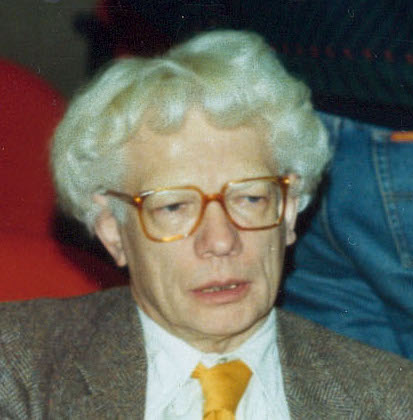Kovalevsky Jean - Gaia
Gaia contributors
Gaia was proposed in 1993 and since then, many people have been involved in the Gaia mission, whether at ESA, at industry side or at one of the institutes involved in the Gaia data processing. The Gaia Data Processing and Analysis Consortium (DPAC) is a collaboration which consists of around 450 scientists and engineers.
The list of Gaia contributors presented here should not be considered a complete representation of the entire consortium and should not be considered as a list of currenly active people on the Gaia mission. A more complete list of Gaia contributors that were involved in the creation of the Gaia catalogues can be obtained from the author lists of the Gaia Collaboration overview papers (for Gaia Data Release 1 see here, for Gaia Data Release 2 see here, for Gaia Early Data Release 3 see here, for the full Gaia Data Release 3 see here, for Gaia Focused Product Release see here). A history of contributions to the Gaia mission can be found from the acknowledgements given with each data release.
Gaia DPAC members who wish to be featured on these pages can contact the Gaia Helpdesk. Anyone who wishes to be removed from this website can contact the Gaia Helpdesk.
|
|
|
 |
Jean Kovalevsky (1929 - 2018) Astronomer Emeritus at the Observatoire de la Côte d'Azur Former chair of the Hipparcos FAST Consortium
|
|
Jean Kovalevsky, one of the key persons that made Hipparcos possible and former chair of the Hipparcos FAST consortium, passed away on Friday 17 August. He was a renowned specialist of celestial mechanics, space geodesy and astrometry. Jean was born near Paris in 1929 from Russian emigrates and he received his early education in French and Russian. He was trained in mathematics at the Ecole Normale Supérieure in Paris and became quickly assistant astronomer at the Observatory of Paris. While completing hid PhD under D. Brouwer in Yale the space era started with the launch of Sputnik I in October 1957. He was one of the first to lecture on the detailed dynamics of Earth artificial satellites which resulted in the publication of the successful monograph "Introduction à la mécaniques céleste' (translated as Introduction to celestial mechanics, Springer). Back in France he founded the 'Service des Calculs et de Mécanique Céleste" of the Bureau des Longitudes where, with talented young researchers, they produced new analytical planetary and lunar theories making use of computer assisted algebra, that are still updated and remain the best available in this category. The purely numerical version INPOP used for Gaia is a direct heir of this school. After having been the first director of a mixed research group in space geodesy combining basic research and the French Space Agency CNES (the group is still existent), Jean Kovalevsky moved to Grasse in Southern France to build the CERGA, a totally new kind of observatory using modern techniques for astrometry and space geodesy, of which he was director from 1974 to 1982. At the same time he initiated and chaired a decisive meeting in Frascati in October 1974 to gather an international community in support of space astrometry and turn an up-to-now French concept into a valuable and fundable European space mission. After several years of technical assessments, renewed designs and through a long process of lobbying the miracle occurred and ESA selected Hipparcos within its science programme in 1980. Jean acted relentlessly in committees and behind the stage to overcome the scepticism of reluctant representatives and had his share in this outstanding success. In 1982 he stepped down as director of CERGA to form and lead the FAST consortium dedicated to Hipparcos data processing, one of the two international groups entrusted by ESA with this daunting task. Despite near loss at launch, Hipparcos mission was a resounding accomplishment which set a fundamentally new approach to astrometry. It clearly paved the way for the much more ambitious Gaia that we know today. Jean followed closely the preparation of Gaia and was member of the Relativity and Reference Frame working group. He attended in April 2017 the IAU 330 in Nice, despite his failing health. He was a fervent admirer of the mission and in a recent interview in a French popular science magazine, he said about Gaia : "I have the hope of a huge harvest of valuable data". Fortunately he could see the second data release of Gaia a few months later. After Hipparcos he first wrote with K. Seidelman the textbook "Fundamentals of Astrometry" and turned his broad science knowledge and keen interest for measurements in general into the field of standards and metrology. He was President of the International Committee for Weights and Measures (CIPM) from 1997 to 2004. In this position his international prestige and negotiating skills were well employed to conduct delicate discussions at the highest levels between the participating states in the International Bureau of Weights and Measures. He was Member of the Bureau des Longitudes since 1968 and Member of the French Academy of Sciences since 1988. Jean and his deceased wife Jeanine have had three children. He is left also with seven grandchildren and six great-grandchildren.
[Published: 21/08/2018]
Jean Kovalevsky at the International Hipparcos Press Conference, 11 April 1988 |
|
- Removed a total of (4) style text-align:center;
- Removed a total of (8) style text-align:justify;
- Removed a total of (1) border attribute.
- Removed a total of (1) cellpadding attribute.
- Removed a total of (1) cellspacing attribute.
Gaia people archive
- Removed a total of (1) style overflow:auto;
- Removed a total of (2) border attribute.
- Removed a total of (2) cellpadding attribute.
- Removed a total of (2) cellspacing attribute.








































 Sign in
Sign in
 Science & Technology
Science & Technology

